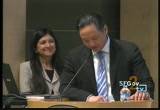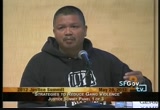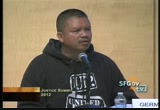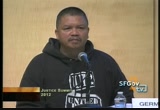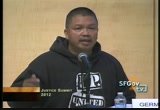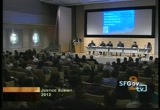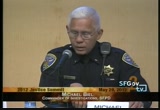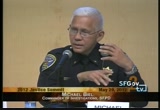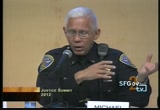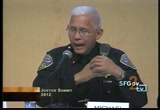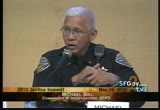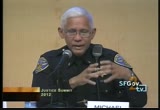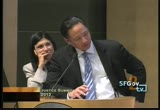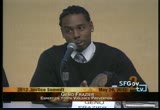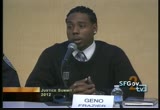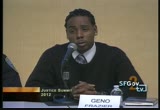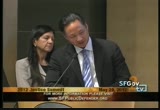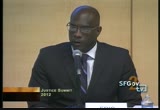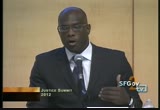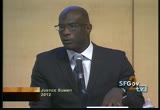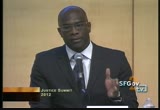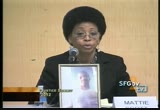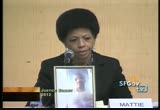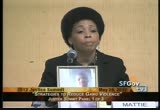tv [untitled] November 15, 2012 2:30am-3:00am PST
2:30 am
scutcheon. you work every day with gang members. you were once a gang member yourself. why do you think you are effective working with young people and what does this mean to you and how we know that this is working. first of all, i want to thank god for his grace. i work with united players. i do reentry and the youth involved in juvenile delinquency. the majority of the kids i work with our gang members. i was formally -- formerly a gang member who grew up in san francisco. we all have stories of guys involved with the gang. everyone has a different story of why they joined. my thing is, i believe it works
2:31 am
for me to be involved with kids who were in gangs -- i worked with all of the shot colors and i had a goal while i was there. it took me 10 years before i started to transform my life. in the meantime i have the goal that i wanted to be out here. i wanted the opportunity. i was given a life sentence in 1979. i was involved in gang and i caught a murder case. 15 years to life -- and i came here in 1979 and i got out -- and i have been out for almost five years. in my heart, i knew i found a
2:32 am
solution when i was incarcerated. and there are different stories. some of the kids joined the gangs because they want to fit into something. some of them don't have a family, and the father and mother are working. for a lot of kids, there is a lot of idle time. it is not like, i will join the gang and i will shoot you. you grow up that way, and before you know you are cutting school. this is begins. working with the different kids that we have, the gangs are still the same -- the game is still the same and the players have changed. some of these kids are savage.
2:33 am
i can look in their eyes. they can go way out -- what works for me is to get their trust. i don't tell them, drugs are bad and this is bad. if you can figure out where this began you can follow this. and why did i join a gang? what attracted me, it was the power that came with it. there was no money involved and nothing involved. we all have different stories. and we have to adjust.
2:34 am
2:35 am
i work with gang members, and they never knew that they were gang members. things have changed their. they isolate themselves. this is so small that they cannot go anywhere. the thing with me, with the kids, is just being able to love them. this does not take you yelling at somebody. all they need is the information. sometimes you go through this maze, and there is a dead-end street.
2:36 am
i am just coming back. i am giving them information that this is not the way to go. there is no certificate for you. you were the gangster of the year. it does not work for everybody. i save the community a lot of heartache. with the crime that he would comment, just one is worth it for me. [applause] >> commander beale. we hear a lot of discussion
2:37 am
about gang interventionists. how should san francisco's gang task force work with these programs? >> well, i'll tell you. i became the commander of investigations a year ago. this is new to me. what i saw was what the men and women do. this was nothing less than amazing. what the task force does is the majority of the contact that they have with the community, it is really about information sharing, talking and getting to know the people, the families, and they do a lot of work in the intervention field as well as
2:38 am
the prevention. with this task force, what they have to do is build those relationships. you cannot do that, with the police and the radio car. you have to get to know them. you have to know them when they are hurting. that is what amazed me. i went into the task force office. i ask them, what is this about? they have adopted the families into the worst housing projects in our city. their own funds that they put together, they will go out to get young kids.
2:39 am
this will build those relationships. what they do, if you work in the community network, this is the guidance of youth and their families. they are made up of former gang members. what they did when they took over as the commander, is to ask them what is going on. i asked her, what can we do to make this better? but i did then, after the discussion i brought in these captains to meet with the personnel. the actual formal gatt -- former gang members. i told them we have to work together. so that when we have an instance of a homicide or a
2:40 am
shooting, we can work together to do the prevention piece of this to prevent retaliation and emotional anchor. what we have decided then, the reason why the crn is cold, at the scene of the incident. they do not communicate with the officers. they are in a precarious situation. they worked at a much closer environment and they cannot be perceived as a snitch. or that they are working with the police department. they are there to, down, emotionally, the anchor. what they do then, we have a shooting war homicide.
2:41 am
and they go to the hospital to be with the families. any talk of retaliation -- they will work with our social workers at the hospital. and whether the retaliation must go next. to saturate and prevent and interrupt any violence that may occur. this is a component or peace that has been building. i polled the captains of payview, mission, ingleside and the northern district. these are the most affected by gang violence. they said they appreciated what
2:42 am
the crn did what they want to see them more. they need to fill that communication. it also comes down to training and trust, to be able to have them talk to officers. they would address the officers, they had arrested some of them, when there were actually under. they will help the police and the community. under his guidance we are the
2:43 am
most active community. of anyone in this country and any department. he puts his money where his mouth is. he tells them to stay out of the gang, and that we have officers with a wilderness program. there are a number of things in the organization in place to start to make change. we have seen this over the last three or four years. in 2008 there were 98 homicides in san francisco. the number is now almost half. i think we continue to see that, as we work with the community. in closing, i want to say that
2:44 am
your task force, they do an amazing job. they have the community aspect of this. they're out on the streets, and we will continue to build those relationships as long as we have this in place. thank you. [applause] >> gino, you grteew up in the ba area. -- bay area. how do you determine the gang? and what makes a person a gang member. >> we grew up in the city of richmond. we are known for violence. i looked at this as being part
2:45 am
of a gang. the term "gang" is manifested through the media, and law enforcement for numbers. it was more of a community. i did not go to school and meet somebody. i lived on this block and this is where my grandmother's house was, or i was born and raised. what people may see on tv was at my front door. the killing and the dope dealing. it was right there. this was a community list of people, we just grew up together. there were no handouts and no one told us how to conduct
2:46 am
ourselves. and tell us what to wear. someone could have a school fight, and we may be at the mall, and see the person we have a fight with. the army and navy have their bar fights. i did not see this as being a game, or a community. supporting each other, this may have been in a negative way. i did not have a stable household. many of them do not of their fathers are, where their father is dead. in their return, the block i
2:47 am
gave up -- this is who i looked up to. he had a notorious reputation. there was the violence and in return, we had the pros and cons for that. a lot of people would mess with me because of who my father was -- to my brother was. they became my enemies. it was not a choice. this is just how was. let's go get him. and it comes to the place, you get tired of running. i did not see this as being
2:48 am
wrong. what people defined as a gang, that must be a gang member right there. i have tattoos on my arm and neck and hand, and none of them are getting associated. they all tell personal story in my life. somebody would say that this is a gang member. there would be the artistic side. i think that this comes to a place where there has to be a level of understanding. they have the school system and the politicians.
2:49 am
everyone plays a part. [applause] >> you have worked as a police officer -- and now you're the prosecutor. you now prosecute all of the gang cases. what is your >> imagine you are 21, you are from mississippi, going through the police academy. it is 1989 and you are now working in los angeles. after being a patrol officer for just a few months, you are placed on gang detail. you have arrested a youth. instead of taking him to jail, you taken to his mother.
2:50 am
the mother says, can you make him more afraid of you that of the gang members? the academy does not prepare you for that. i take that experience and i realized in the gang environment, most of these youths are coming from single- family households. in the area where the gang violence is most prevalent, great citizens of the community, 99% of those citizens are afraid. as a prosecutor, i take this experience and figure out how i want to enforce gang violence, especially in san francisco. i break it down into three categories. you have the individual who is not fully immersed in the gang lifestyle. he is just an associate comment just hanging out. -- associates, just hanging out.
2:51 am
for that individual, we try to work with community-based programs. i've met with dcyf, the african- american steering committee, people haven't been in this violence and i say to them, what can -- people have been in this violence, and i say to them, what can we do to make sure if this individual does not go to prison? for that individual, we try to find a way to keep him out of the prison sentence. then you have the second individual, the individual who does crimes not for economic means, but for someone who has tried to increase the status in the community, for someone who does not care about anything but being notorious for gang
2:52 am
violence. for that individual, we have to have certain types of remedies. for that individual, we have to have consequences. however, it does not mean that we have to enforce his prison sentence to the maximum of the law. we have a step program, which increases the amount of time you can go to a prison ford -- prison. for a home invasion, or a carjacking, or shooting into a car or house, you cannot 15 to life. for a regular felony, you can add five years. for that individual, we do not always seek to add that extra 10 years. we hope that person realizes, you almost spend the rest of your life in prison. it is up to you to see what you were going to do with that.
2:53 am
and then we have the third group. they're committing the most violent crimes. the individuals that come together as a force, they are enforcing their will on a community in the bayview, western addition, the mission. those individuals are dressed in a different way. -- addressed in a different way. we will do an indictment. the fed will do the same thing, they will indict maybe 15, 20 dain members. it is our hope that we have taken a group of individuals out of the community to protect the younger individuals. indictment that we did with 10 gang members in bayview. we only went after the 10 most violent gang members. the ones committing murders, robberies. within their gangs, there was another subset of the individuals doing burglaries.
2:54 am
those are not the individuals we went after. we went after the most violent ones. by getting of the most violent ones, what happens there was below of homicide, robbery is entailed -- and a lull in retaliatory shootings. what has to be done, you have to find a way to address that lull when it occurs. when he to find a way to have intervention when certain of the most violent members are taken off the streets. we look at the context of the individual, the external factors, and we try to find the appropriate remedy. [applause]
2:55 am
>> you started an organization that helps parents who have suffered the death of their child or children by violence. what made evaded you to do this? >> but what motivated you to do this? >> good morning, so glad to be here. i want to thank you for inviting me to this panel. giving honor to god for allowing me to be here today to do this work. if it was not for him, i could not be here. i do this work, at it is not just me, it is over 300 families that we represent in san francisco alone. the reason why i do this. i do it because my son was
2:56 am
murdered in the western addition july 17, 1996, a day before his oldest son, at the age of 5, his birthday was the next day. this is the reason why i do it. 300 family is, over 350 families in san francisco alone that i know personally, that are members of the healing circle, cases have not been solved. she lost three sons to gun violence in the month of august. that is the reason why i do. i do it because betty cooper lost two sons in the bay view to violence. it still remains unsolved. in 1996, when my son was killed, 96 homicides in san
2:57 am
francisco. everybody seemed to think that it was just another day in my community. no one knew the pain i was suffering. no one knew when i was going through. no one knew how this affected my family, my children, my community. no one seemed to care. i do it because what happened in columbine should have happened in my neighborhood, and it did not. there was no one there for me when this happened to me. [applause] there were no counselors, and nobody come into my house to ask me questions about what happened. the already labeled my son in the papers as a gang member. they labeled him as a drug dealer. no be had came to me -- no media
2:58 am
came to me to ask me about my child. the people in my community seamen visible -- seemed invisible, and that seems unfair. i do because i want to see justice. i want to look at the person who killed my son and asked him why. why did you kill my son? what was so -- what did he do that allow you to shoot him point blank with four bullets in the face? what would make you do such a thing? i want to meet the individual, to let him know i have already forgiven you. if i had not for giving you, i would not be here today. i have to forgive you, but i want to know why. why do i want to know why? i want to get you killed, too. kurds people -- hurt people hurt
2:59 am
people. apparently, you are hurting. you had to be hurting that night to shoot my son in the face. you knew him, you ate at my house, you spend time together. i want to know why you killed my son. i want to know why. i want to know why the community did not step up. everybody was present. i want to know why came to say who did it. i want answers. like all the 300 mothers that we represent in the healing circle, they ask the same question. i want to know why along with the over 30,000 unsolved homicides since the 1990's. ve
64 Views
IN COLLECTIONS
SFGTV2: San Francisco Government Television Television Archive
Television Archive  Television Archive News Search Service
Television Archive News Search Service 
Uploaded by TV Archive on

 Live Music Archive
Live Music Archive Librivox Free Audio
Librivox Free Audio Metropolitan Museum
Metropolitan Museum Cleveland Museum of Art
Cleveland Museum of Art Internet Arcade
Internet Arcade Console Living Room
Console Living Room Books to Borrow
Books to Borrow Open Library
Open Library TV News
TV News Understanding 9/11
Understanding 9/11